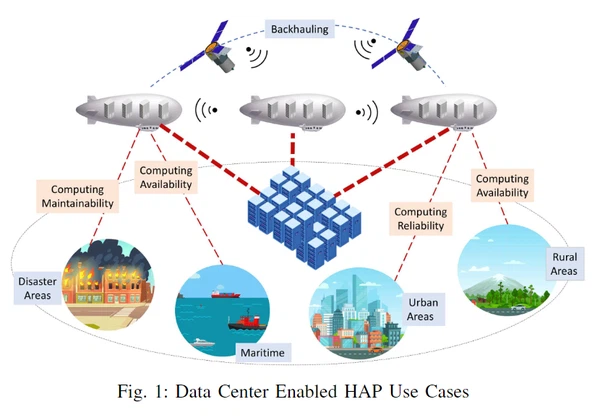It is not strange for the data center industry to leverage innovative sustainability solutions. For a long time, the Earth's natural resources have been used as a means to improve energy efficiency, from facilities built in cooler, higher latitudes to data centers built directly on the ocean floor to maximize seawater cooling. But what if we set our sights higher up on Earth?
What Is HAP?
Recently, satellite data centers have attracted increasing interest as a newly defined computing frontier. However, this data center architecture has several drawbacks, such as high cost, additional latency, and limited payloads. Interestingly, high-altitude platforms (HAP) appear to be a good trade-off between these combined technologies, as they provide a larger coverage area than underwater systems, support more significant payloads, and guarantee easier maintenance and lower latency than satellites.
The term "HAP(High Altitude Platform)" usually refers to a platform hovering at a high altitude, such as a blimp, balloon, or drone above the atmosphere. Published in October 2023, Data Center-Enabled High Altitude Platforms: A Green Computing Alternative evaluates the potential energy benefits of the HAP, a conceptual data center system in which servers are housed in a helium-filled blimp-like airship.
Why Do We Enable HAP For Data Center?
First, HAP is located in the stratosphere, which saves cooling energy due to the naturally lower atmospheric temperature (between 50 degrees Celsius and 15 degrees Celsius). As a result, HAP that supports data centers can offload some workloads from ground data centers, saving the associated cooling energy.
In addition, due to HAP's large surface and its position above the clouds, HAP can host large solar panels, thus obtaining a large amount of solar energy. HAP supplies the server with solar energy collected during the day and stored in lithium-sulfur batteries at night. Therefore, the collected solar energy can fully cover the computing power required by the data center servers; At the same time, necessary energy conversion and management strategies are effectively applied.
Second, HAP is located at a high altitude, and due to the large ground coverage and no obstacles on the horizon, LoS communication links with multiple receivers are possible. As a result, HAP can establish a reliable direct link with a large number of ground base stations. These advantages enable HAP, which supports data centers, to provide a wealth of computing services ranging from supporting iot applications to intelligent transportation systems, as shown in Figure 1.

Challenged By The Reality
Notice, this proposed solution is still largely a theoretical concept. The researchers themselves are quick to highlight the numerous challenges that need to be overcome to make high-altitude platform data centers a reality.
It is important to reduce the energy consumed by the ground data center by maximizing the number of on-board servers and the compute effort offloaded to HAP. However, the adoption of this technology leads to a resource utilization dilemma because energy consumption and resource utilization are strongly coupled. On the one hand, overutilization of available resources threatens the physical capabilities of the system and can produce dysfunctional servers or unbalanced HAP. For example, high central processing unit (CPU) utilization and/or memory utilization overload the server and cause the system to become unresponsive or freeze.
On the other hand, underutilization of available resources can lead to server aging and significant energy waste, as idle servers can consume up to 60% of their peak power. Therefore, it is valuable to employ appropriate resource management (e.g. consolidation, containerization) techniques in HAP supporting data centers to reduce the amount of energy consumed without neglecting the physical capacity of available resources.
From a financial point of view, the economic viability of HAP supporting the data center needs to be considered. This involves capital expenditures, such as the cost of HAP platform and over-the-air servers, as well as operational expenditures, such as energy costs. On the overall assessment of profitability, they may prolong HAP adoption. From a technical point of view, HAP faces technical challenges as unstable weather conditions in the stratosphere place greater demands on electronics. In addition, maintaining high-altitude airships and servers requires balancing considerations between computational quality of service and mission duration.
Taken together, HAP supporting the data center as an innovative sustainability solution can drive a rethink of where data is processed to improve sustainability. Although some challenges remain to be solved, this novel concept offers a possibility for future data center development. Further research and practice is needed to overcome the technical and financial challenges and maximize its potential energy benefits.


